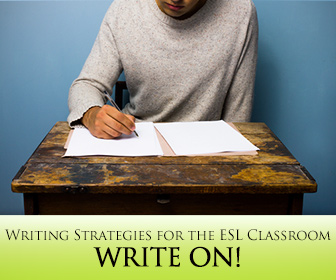All of your ESL students can write words in English.
Most of them can even write complete sentences. But they can’t really write. Writing, and I mean good writing, whether it is in your native or second language is not easy. And it’s not something we do intuitively, naturally. Good writing has to be taught.
Let’s face the facts. Students want to speak English. They rarely want to write (and if they do, it’s email writing for business purposes). But it is absolutely essential for ESL students to learn solid writing strategies. Good writing skills, in any language, are a big advantage in the job market and vital for academic success. So, let’s look at the writing strategies you should be teaching – today!

How to Teach Writing Strategies
-
1
Choose a Strategy
Consider your students’ level of English but also what they are struggling with. Do they need to learn to organize their writing? Do they need to get their point across more clearly? Do they simply need to write more? First, consider your goal and choose the strategy that will help you achieve it.
-
2
Model it
Give them samples of the type of writing they are expected to achieve. Read them in class. Write something together, as a class or in small groups. Guide them step by step. For example, if you’re teaching them to write an email, instruct them to write the greeting, the purpose of the email and the closing.
-
3
Let Them Try it on Their Own - with Your Assistance
The next logical step is to instruct them to write on their own, but walk around the classroom and offer support and guidance to those who need it.
-
4
Independent Practice
There’s no better way to improve writing than by practicing and then practicing some more. Give them writing assignments they must complete on their own and then turn in. Make sure to give the kind of feedback that will encourage them to keep writing. Of course, you have to correct mistakes but focus on how well they have used a particular writing strategy. Maybe their text is plagued with spelling mistakes, but the text is clear and well-organized.

The Writing Process
Students should be familiar with the basic writing process:
- Generate ideas
- Organize and develop ideas
- Edit
You can ask students to generate ideas on their own; you can do it as a class. But they must know what they will write about before they put pen to paper. The way they organize their thoughts will depend on the writing strategy you are teaching. Editing and revision should be left for last.

Some Writing Strategies for the ESL Classroom
-
1
Fast and Furious Writing
Say you’re trying to foster creative writing. Nothing kills creativity faster than agonizing over every single word and how it’s spelled. This exercise is great for when you want to get those creative juices flowing. Remember and remind students that this is not a grammar or spelling exercise. The main objective is to get some writing done! Give them a topic to write about – make it easy, something that will flow easily, like a narrative: Write about the best summer vacation you ever had.
Tell them they will have a time limit (say 10-15 minutes). They must write as fast as they can, just letting the words flow. No erasing or pausing. Give them a one minute warning before time is up. Once they’re done, they will have produced what they should consider a raw material, not the final piece of writing. Help them polish this raw material for grammar, spelling and structure. They should start the revision process on their own and submit it to you for a final revision.
-
2
Getting Graphic
Graphic organizers are excellent tools for organizing writing. Word clusters or Topic Wheels are great for brainstorming ideas they will cover in their topic. Story Maps are perfect for students who are learning to write a story.
-
3
Using Templates
Nothing inhibits writing more than a blank sheet of paper. Similar to graphic organizers, templates are forms that have blanks or questions students can complete, or samples they can model. Typical templates used for ESL students are email, CVs or resumes, and reviews. Young learners in particular need templates more than adult learners. For example, this template helps them write about their holidays by giving them prompts.
-
4
Addressing the Reader
One aspect of good writing that students need to know is that they must always address the reader. What does the reader need to know? What questions can they expect the reader to ask? For example, if you're writing an email to invite people to a special event, you can expect them to want to know when and where it will be held.
Bear in mind that ESL students need specific types of writing strategies.
They may rarely have to write lengthy essays or reports (or they might have to, particularly students who will sit for international examinations). Give them the type of writing they will need. And give them the tools to get it done.
P.S. If you enjoyed this article, please help spread it by clicking one of those sharing buttons below. And if you are interested in more, you should follow our Facebook page where we share more about creative, non-boring ways to teach English.







